|
|
 |
Fiche d'espèce de Copépode |
|
|
Calanoida ( Ordre ) |
|
|
|
Diaptomoidea ( Superfamille ) |
|
|
|
Candaciidae ( Famille ) |
|
|
|
Candacia ( Genre ) |
|
|
| |
Candacia curta (Dana, 1849) (F,M) | |
| | | | | | | Syn.: | Candace curta Dana,1849; Giesbrecht,1892 (p.424, 439, figs.F,M);
Candace intermedia T. Scott, 1894 b (p.61, figs.F,M);
Candacia intermedia : Pesta, 1941 (p.158);
Candace pectinata (part.) : Brady, 1883 (p.67);
C. bicornuta Mori, 1932 a (p.170, figs.F,M); Pesta, 1941 (p.158); Sewell, 1948 (p.408, 410) | | | | Ref.: | | | Giesbrecht & Schmeil, 1898 (p.129); Thompson & Scott, 1903 (p.235, 251); Esterly, 1905 (p.196, figs.M); A. Scott, 1909 (p.152, Rem.); Wolfenden, 1911 (p.357); Sars, 1925 (p.351); Farran, 1929 (p.210, 272); Sewell, 1932 (p.335); Tanaka, 1935 a (p.212, figs.F,M, juv.); Farran, 1936 a (p.114); Mori, 1937 (1964) (p.83, figs.F,M); Pesta, 1941 (p.160, figs.F,M); Wilson, 1942 a (p.174, fig.F); Sewell, 1947 (p.246); Marques, 1953 (p.120); Chiba & al., 1957 (p.310); 1957 a (p.11); Marques, 1958 (p.216); Chiba, 1956 (p.37, figs. Juv.M, Rem.); Brodsky, 1962 c (p.139, figs.F,M); Grice, 1962 (p.231, figs.F,M); 1963 (p.175, figs.F,M); Paiva, 1963 (p.69, figs.F,M); Tanaka, 1964 c (p.244); Vervoort, 1965 (p.159, Rem.); Chen & Zhang, 1965 (p.90, figs.F,M); Owre & Foyo, 1967 (p.92, figs.F,M); Vidal, 1968 (p.40, figs.F,M); Corral Estrada, 1970 (p.196, figs.F, M, Rem.); Lee & al., 1971 (p.1150); Marques, 1973 (p.243); Lawson, 1977 (p.71, tab.2,3,4, fig.3,5); Dawson & Knatz, 1980 (p.8, figs.F,M); Björnberg & al., 1981 (p.657, figs.F,M, Rem.); Zheng & al., 1982 (p.67, figs.F); Baessa-de-Aguiar, 1989 (1992) (p.113, figs.F,M); Chihara & Murano, 1997 (p.753, Pl.74,78: F,M); Mulyadi, 1997 a (p.85, Redescr.F,M, figs.F,M); Bradford-Grieve & al., 1999 (p.885, 956, figs.F,M); Conway & al., 2003 (p.107, figs.F,M, Rem.); Mulyadi, 2004 (p.84, figs.F,M, Rem.); Vives & Shmeleva, 2007 (p.446, figs.F,M, Rem.) | 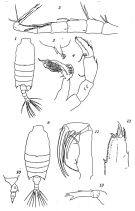 issued from : O. Tanaka in Suisan Gakkai Ho, Tokyo, 1935, 6 (4). [Pl.II, p.219; Pl.III, p.221]. Female: 9, habitus (dorsal view); 10, last thoracic segment and urosome; 11, Mx2; 12, segment 3 of exopodite of P3; 13, P5. Male: 1, habtus (dorsal view); 2, last thoracic segment (lateral view); 3, A1 (right side); 4, P5.
|
 issued from: Q.-c Chen & S.-z. Zhang in Studia Marina Sinica, 1965, 7. [Pl.36, 3-8]. Female (from E China Sea): 3, habitus (dorsal); 4, urosome (ventral); 5, P5 (posterior). Male: 6, habitus (dorsal); 7, right A1 (16th-18th segments); 8, P5 (posterior).
|
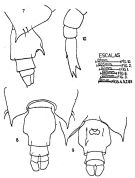 issued from : J. Corral Estrada in Tesis Doct., Univ. Madrid, A-129, Sec. Biologicas, 1970. [Lam.51, figs.7-10]. Female: 7, posterior part cephalothorax and urosome (lateral right side); 8, idem (dorsal); 9, idem (ventral); 10, P5.
|
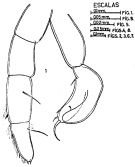 issued from : J. Corral Estrada in Tesis Doct., Univ. Madrid, A-129, Sec. Biologicas, 1970. [Lam.52, fig.1]. Male: 1, P5. Nota: left P5 is slightly different from that Grice (1962) and Paiva (1963), with 4 outer spines and 1 seta on the distal segment
|
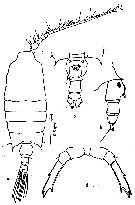 issued from : Z. Zheng, S. Li, S.J. Li & B. Chen in Marine planktonic copepods in Chinese waters. Shanghai Sc. Techn. Press, 1982 [p.67, Fig.38]. Female: a, habitus (dorsal); b, urosome (lateral, right side); c, idem (ventral); d, P5. Scale bar in mm.
|
 issued from : C.O. Esterly in Univ. Calif. Publs. Zool., 1905, 2 (4). [p.196, Fig.46]. Male (from San Diego Region): a, last thoracic segment and genital segment (lateral); b, same (dorsal); c, P5 (right leg at right of figure).
|
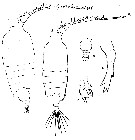 issued from : T. Mori in The Pelagic copepoda from the neighbouring waters of Japan, 1937 (1964). [Pl. 57, Figs.1-5]. Female: 1, habitus (dorsal); 3, urosome (ventral); 4, P5. Male: 2, habitus (dorsal); 5, P5.
|
 issued from : T. Mori in The Pelagic copepoda from the neighbouring waters of Japan, 1937 (1964). [Pl. 56, Figs.1-8]. Female: 2, habitus (dorsal); 3, P5; 4, P3; 5, Mx2; 6, urosome (ventral); 7, P4. Male: 1, habitus (dorsal); 8, P5.
|
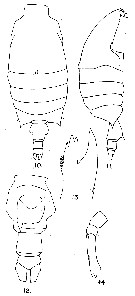 issued from : G.D. Grice in Fish. Bull. Fish and Wildl. Ser., 1962, 61. [p.232, Pl.30, Figs.10-14]. Female (from equatorial Pacific): 10-11, habitus (dorsal and lateral); 12, urosome (ventral); 13, Md (biting edge); 14, P5. Nota: Genital segment slightly asymmetrical in dorsal view., with a spine-like protrusion on the ventral side; this spine-like originates from the right side of the segment. The basal tooth of Md has 3 cusps, the lowermost one of which arises from behind the other two. Tgere are 2 points on the distal end of P5 and another point a short distance back of the distal end
|
 issued from : G.D. Grice in Fish. Bull. Fish and Wildl. Ser., 1962, 61. [p.233, Pl.31, Figs.1-3]. Male: 1, habitus (dorsal); 2, posterior part of thorax and genital segment (right side); 3, P5. Nota: Right posterior thoracic margin ends in a hooked spine-like point and there is a curved, pointed protrusion from the right side of the genital segment. Chela of P5 characteristic.
|
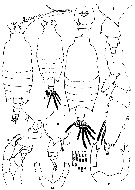 issued from : Mulyadi in Published by Res. Center Biol., Indonesia Inst. Sci. Bogor, 2004. [p.85, Fig.47]. Female (from Banda Sea): A, habitus (dorsal); B, angle of the 5th metasomam somite and urosome (lateral left side); C, genital somite (ventral); D, P3; E, P5 (anterior view). Female (immature): F, habitus (dorsal); G, 5th metasomal somite and urosome (lateral right side); H, P5. Male: I, habitus (dorsal); J, 5th metasomal somite and 1st and 2nd urosomal somite (lateral right side); K, P5 (posterior view).
|
 Issued from : J.M. Bradford-Grieve, E.L. Markhaseva, C.E.F. Rocha & B. Abiahy in South Atlantic Zooplankton, edit. D. Boltovskoy. 1999, Vol. 2, Copepoda; [p.1064, Fig. 7.365: Candacia curta ]. Ur = urosome; Pd = pedigerous segment; Gns = genital segment; r = right leg; l = left leg. Female characteristics (from key, p.956) : - Spine-like process present on ventral side of genital segment. - No inner edge setae present on terminal segment of P5. - Urosomal segment 2 without lateral or ventral protrusion and without spine-like process arising from ventral surface. - Posterior corners of prosome pointed. Male characteristics (from key, p.956) : - In lateral view, right posterior prosome corner not truncate, and not reaching posterior border of genital segment and turned upwards. - Right A1 with segments 19 and 20 fused or partially fused. - Right A1 with segments 17 and 18 separate. - Right A1 with segments 2 and 3 fused. - In dorsal view, genital segment with process. - Left posterior corner of the prosome pointed.
|
 Issued from : W. Giesbrecht in Fauna Flora Golf. Neapel, 1892, 19. [Taf. 39, figs. 8, 12]. Female: 8, Thoracic segment 5 and abdominal segments 1 and 2 (lateral); 12, urosome (ventral).
|
 Issued from : W. Giesbrecht in Fauna Flora Golf. Neapel, 1892, 19. [Taf. 39, figs. 9, 10]. Male: 9, thoracic segment 5 and abdominal segments 1 and 2 (lateral); 10, same (dorsal).
|
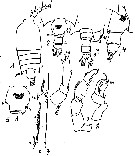 Issued from : M.C. Kos in Field guide for plankton. Zool Institute USSR Acad., Vol. I, 1972. As Candacia aethiopica. After Mori, 1937, redrawn from Brodsky, 1962/ Female: 1, habitus (dorsal); 2, corner of the last thoracic segment and abdomen (ventral); 4, same (lateral); 5, genital segment (ventral); 6, P5. Male: 7, A1 (grasping segments); 8, P5.
| | | | | Ref. compl.: | | | Cleve, 1904 a (p.186); Carl, 1907 (p.17); Wilson, 1942 a (p.174); Sewell, 1948 (p.391, 396, 408, 412, 414, 433, 443, 450, 457, 460); C.B. Wilson, 1950 (p.181); Yamazi, 1958 (p.151, Rem.); Fagetti, 1962 (p.33); Cervigon, 1962 (p.181, tables: abundance distribution); Ganapati & Shanthakumari, 1962 (p.9, 15); Ahlstrom & Thrailkill, 1963 (p.57, Table 5, abundance); Gaudy, 1963 (p.28, Rem.); Björnberg, 1963 (p.56, Rem.); De Decker, 1964 (p.15, 19, 27); De Decker & Mombeck, 1964 (p.11); Neto & Paiva, 1966 (p.27, Table III); Fleminger, 1967 a (tabl.1); Delalo, 1968 (p.138); Binet & al., 1972 (p.71); Bainbridge, 1972 (p.61, Appendix Table I: vertical distribution vs day/night, Table II: %, Table IV: seasonal abundance); Björnberg, 1973 (p.349, 385); Corral Estrada & Pereiro Muñoz, 1974 (tab.I); Carter, 1977 (1978) (p.36); Dessier, 1979 (p.206); Arashkevich & al., 1982 (p.477, Table 2 cont., diet); Vives, 1982 (p.294); Kovalev & Shmeleva, 1982 (p.85); Dessier, 1983 (p.89, Tableau 1, Rem., %); Guangshan & Honglin, 1984 (p.118, tab.); De Decker, 1984 (p.317); Brenning, 1985 a (p.28, Table 2); Greze & al., 1985 (p.8); Brinton & al., 1986 (p.228, Table 1); Chen Y.-Q., 1986 (p.205, Table 1: abundance %, Table 2: vertical distribution); Madhupratap & Haridas, 1986 (p.105, tab.1); Brenning, 1987 (p.28, spatial distribution, T-S diagram, Rem.); Jimenez-Perez & Lara-Lara, 1988; Lozano Soldevilla & al., 1988 (p.60); Hernandez-Trujillo, 1989 a (tab.1); Cervantes-Duarte & Hernandez-Trujillo, 1989 (tab.3); Echelman & Fishelson, 1990 a (tab.2); Suarez & al., 1990 (tab.2); Yoo, 1991 (tab.1); Ohtsuka & Kubo, 1991 (p.541); Samba Diouf, 1991 (p.104); Hernandez-Trujillo, 1991 (1993) (tab.I); Suarez & Gasca, 1991 (tab.2); Suarez, 1992 (App.1); Palomares Garcia & Vera, 1995 (tab.1); Shih & Young, 1995 (p.69); Park & Choi, 1997 (Appendix); Alvarez-Cadena & al., 1998 (tab.2,3); Suarez-Morales & Gasca, 1998 a (p108); Noda & al., 1998 (p.55, Table 3, occurrence); Lavaniegos & Gonzalez-Navarro, 1999 (p.239, Appx.1); Neumann-Leitao & al., 1999 (p.153, tab.2); Onishchik, 1999 (p.76); Fernandez-Alamo & al., 2000 (p.1139, Appendix); Suarez-Morales & al., 2000 (p.751, tab.1); Lopez-Salgado & al., 2000 (tab.1); Rebstock, 2001 (tab.2); 2002 (p.71, Table 3, 6, Figs.2, climatic variability); Hernandez-Trujillo & Suarez-Morales, 2002 (p.748, tab.1); Beaugrand & al., 2002 (p.179, figs.5, 6); Hwang & al., 2003 (p.193, tab.2); Hsiao & al., 2004 (p.325, tab.1); Osore & al., 2004 (p.195); Razai & al., 2004 (p.490, tab.2); Lan & al., 2004 (p.332, tab.1); Gallienne & al., 2004 (p.5, tab.3); Lo & al., 2004 (p.89, tab.1); Kazmi, 2004 (p.228); Camisotti & al., 2005 (p.99); Lopez-Ibarra & Palomares-Garcia, 2006 (p.63, Tabl. 1, seasonal abundance vs El-Niño); Zuo & al., 2006 (p.162: tab.1); Lavaniegos & Jiménez-Pérez, 2006 (p.137, tab.2, 3, Rem.); Dur & al., 2007 (p.197, Table IV); Khelifi-Touhami & al., 2007 (p.327, Table 1); Ayon & al., 2008 (p.238, Table 4: Peruvian samples); Neumann-Leitao & al., 2008 (p.799: Tab.II, fig.6); Lan Y.C. & al., 2008 (p.61, Table 1, % vs stations); C.-Y. Lee & al., 2009 (p.151, Tab.2); Miyashita & al., 2009 (p.815, Tabl.II); C.E. Morales & al., 2010 (p.158, Table 1); Hernandez-Trujillo & al., 2010 (p.913, Table 2); Cornils & al., 2010 (p.2076, Table 3); Medellin-Mora & Navas S., 2010 (p.265, Tab. 2); W.-B. Chang & al., 2010 (p.735, Table 2, abundance); Hsiao S.H. & al., 2011 (p.475, Appendix I); Maiphae & Sa-ardrit, 2011 (p.641, Table 2); Tutasi & al., 2011 (p.791, Table 2, abundance distribution vs La Niña event); Teuber & al., 2013 (p.1, Table 1, 2, abundance vs oxygen minimum zone, respiration rates); in CalCOFI regional list (MDO, Nov. 2013; M. Ohman, pers. comm.); Tseng & al., 2013 (p.507, seasonal abundance); Hirai & al., 2013 (p.1, Table I, molecular marker); Lidvanov & al., 2013 (p.290, Table 2, % composition); Fierro Gonzalvez, 2014 (p.1, Tab. 3, 5, occurrence, abundance); Zakaria & al., 2016 (p.1, Table 1, Rem.); Palomares-Garcia & al., 2018 (p.178, Table 1: occurrence) | | | | NZ: | 18 | | |
|
Carte de distribution de Candacia curta par zones géographiques
|
| | | | | | | | | | | |  Carte de 1996 Carte de 1996 | |
 issued from : T.J. Lawson in Marine Biology, 1977, 43. [Fig.5, p.79]. issued from : T.J. Lawson in Marine Biology, 1977, 43. [Fig.5, p.79].
Distribution map for the Indian Ocean. |
 issued from : Mulyadi in Treubia, 1997, 31 (2). [p.109, Fig.16]. issued from : Mulyadi in Treubia, 1997, 31 (2). [p.109, Fig.16].
Distribution of Candaciidae in Indonesian waters. 4: C. curta. |
 issued from : G.A. Rebstock in Global change Biology, 2002, 8. [p.77, Fig.2 p]. issued from : G.A. Rebstock in Global change Biology, 2002, 8. [p.77, Fig.2 p].
Climatic regime shifts and decadal-scale variability in calanoid copepod populations off southern California (31°-35°N, 117°-122°W.
Cumulative sums of nonseasonal anomalies from the long-term means of copepod abundance from years 1950 to 2000.
A negative slope indicates a period of below-average anomalies; a positive slope indicates a period of above-average anomalies. Abrupt changes in slope indicate step changes. Step changes are marked with arrow (upward-pointing for increases).
The October 1966 cruise (prior to the increase in sampling depth), March 1976 cruise (prior to the 1976-77 climatic regime shift), and October 1988 cruise (prior to the hypothesized 1989 climatic regime shift) are marked with vertical lines. |
 issued from : U. Brenning in Wiss. Z. Wilhelm-Pieck-Univ. Rostock - 36. Jahrgang 1987. Mat.-nat. wiss. Reihe, 2. [p.27, Fig.1]. issued from : U. Brenning in Wiss. Z. Wilhelm-Pieck-Univ. Rostock - 36. Jahrgang 1987. Mat.-nat. wiss. Reihe, 2. [p.27, Fig.1].
Spatial distribution for Candacia curta, C. armata, C. bipinnata, C. paenelongimana, C. varicans (as varians), C. pachydactyla, C. longimana, C. ethiopica, Paracandacia simplex ( = C. simplex) from 8° S - 26° N; 16°- 20° W, for different expeditions (V1: Dec. 1972- Jan. 1973; V2: Feb/Mar. 1973; VI: May 1974; IV: Jun./Jul. 1972). |
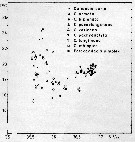 issued from : U. Brenning in Wiss. Z. Wilhelm-Pieck-Univ. Rostock - 36. Jahrgang 1987. Mat.-nat. wiss. Reihe, 2. [p.28, Fig.2]. issued from : U. Brenning in Wiss. Z. Wilhelm-Pieck-Univ. Rostock - 36. Jahrgang 1987. Mat.-nat. wiss. Reihe, 2. [p.28, Fig.2].
T-S Diagram for Candacia curta, C. armata, C. bipinnata, C. paenelongimana, C. varicans, C. pachydactyla, C. longimana, C. ethiopica, Paracandacia simplex ( = C. simplex) from 8° S - 26° N; 16°- 20° W.
So: water from south; ND: surface water fom north; SD: surface water from south. |
| | | | Loc: | | | South Africa (E & W), Angola, Baia Farta, Congo, off N St. Helena Is., off Gabon, off E Sao Tomé , G. of Guinea, off Lagos, Ivorian shelf, Dakar, Cape Verde Is., off Morocco-Mauritania, Canary Is., off Madeira, Brazil, off Rio de Janeiro, off Natal, off Amazon, Caribbean Colombia, Cariaco Basin, Caribbean Sea, Yucatan, G. of Mexico, Cuba, Florida, Sargasso Sea, W Medit. (Alboran Sea, Gulf of Annaba, W Egyptian coast), G. of Aqaba, Red Sea, G. of Aden, G. of Oman, Arabian Sea, Sri Lanka, Kenya, Madagascar (Tulear, Nosy Bé), Rodrigues Is. - Seychelles, Natal, Mascarene Basin, Indian, India (Lawson's Bay), Nicobar Is., Nankauri Harbour, Straits of Malacca, Amboine Bay, Indonesia-Malaysia, Flores Sea, SW Celebes, China Seas (Yellow Sea, East China Sea, South China Sea), Taiwan (S, SW, E, NW, NE), S Korea, Japan Sea, Japan, Kuchinoerabu Is., Izu region, Tanabe Bay, off Alaska, Pacif. (W equatorial), Australia (Great Barrier), Bikini Is., California, W Baja California, Bahia Magdalena, G. of California, La Paz, G. of Tehuantepec, W Mexico, Pacif. (equatorial), W Colombia, off Peruvian coast, Easter Is., Galapagos-Ecuador, Chile (off Valparaiso, Concepcion) | | | | N: | 157 (N Atlant.: 36; S Atlant.: 25; Medit.: 4; Red Sea: 5; Indian: 23; Indo-Malaysia: 10; Pacif.: 64) | | | | Lg.: | | | (16) F: 2,45-1,82; M: 2,35-1,9; (34) F: 2,35; M: 2,28; (46) F: 2,7-2,6; M: 2,65-2,4; (73) F: 2,66-2,58; M: 2,31-2,17; (91) F: 2,7-2,2; M: 2,65-2,2; (101) F: 2,62-2,28; M: 2,34-2,2; (120) F: 2,4; M: 2,54; (142) M: 1,5; (150) F: 2,63-2,5; (151) F: 2,23; M: 2,14; (180) F: 2,2; 2,18; M: 2,06; (187) F: 2,55-2,4; M: 2,5-2,2; (237) F: 2,1, M: 2,3; (290) F: 2,5-2,45; M: 2,25-2,2; (778) F: 2,14; M: 2,2; (806) F: 2,3-2,15; M: 2,15; (991) F: 1,82-2,7; M: 1,9-2,65; (1023) F: 2,46; (1110) F: 2,1-2,9; M: 2,1-2,7; (1122) F: 2,14; M: 2,2; (1125) F: 2,2; (1230) F: 2,2-2,7; M: 2,2-2,7; {F: 1,82-2,90; M: 1,50-2,70}
The mean female size is 2.375 mm (n = 32; SD = 0.2583), and the mean male size is 2.261 mm (n = 27; SD = 0.2619). The size ratio (male : female ) is 0.92 (n = 17; SD = 0.2358). | | | | Rem.: | épi-bathypélagique.
Voir aussi les remarques en anglais | | | Dernière mise à jour : 14/06/2021 | |
|
|
 Toute utilisation de ce site pour une publication sera mentionnée avec la référence suivante : Toute utilisation de ce site pour une publication sera mentionnée avec la référence suivante :
Razouls C., Desreumaux N., Kouwenberg J. et de Bovée F., 2005-2024. - Biodiversité des Copépodes planctoniques marins (morphologie, répartition géographique et données biologiques). Sorbonne Université, CNRS. Disponible sur http://copepodes.obs-banyuls.fr [Accédé le 26 avril 2024] © copyright 2005-2024 Sorbonne Université, CNRS
|
|
 |
 |























